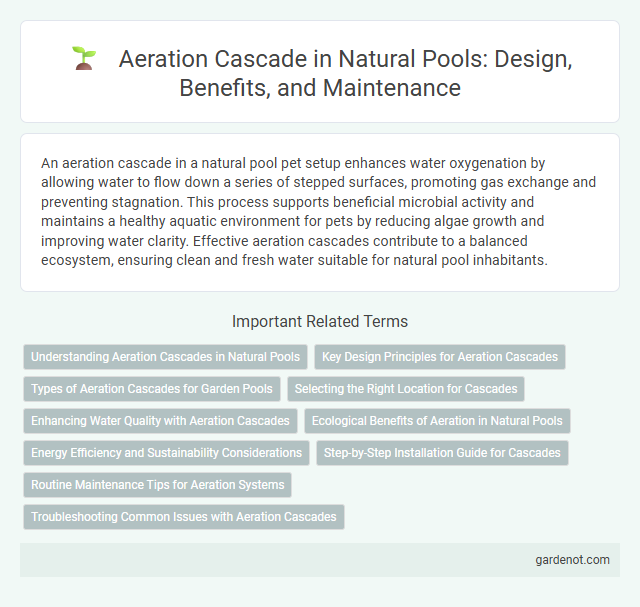An aeration cascade in a natural pool pet setup enhances water oxygenation by allowing water to flow down a series of stepped surfaces, promoting gas exchange and preventing stagnation. This process supports beneficial microbial activity and maintains a healthy aquatic environment for pets by reducing algae growth and improving water clarity. Effective aeration cascades contribute to a balanced ecosystem, ensuring clean and fresh water suitable for natural pool inhabitants.
Understanding Aeration Cascades in Natural Pools
Aeration cascades in natural pools enhance water oxygenation by promoting continuous movement and exposure to air, which supports aquatic life and improves water clarity. These cascades utilize a series of stepped flows where water cascades over rocks or engineered structures, increasing surface area for gas exchange. Properly designed aeration cascades reduce stagnation, balance ecosystem health, and maintain natural pool sustainability.
Key Design Principles for Aeration Cascades
Aeration cascades enhance oxygen transfer in natural pools by maximizing water exposure to air through a series of stepped drops, which increases dissolved oxygen levels crucial for aquatic life and water clarity. Key design principles include optimizing the height and spacing of cascade steps to balance water velocity and aeration efficiency, ensuring smooth, turbulent flow without excessive splashing or noise. Materials should promote durability and mimic natural aesthetics, while maintaining easy maintenance access and supporting beneficial microbial activity.
Types of Aeration Cascades for Garden Pools
Aeration cascades for garden pools come in various types including multi-tiered rock falls, sheet water flows, and step cascades, each designed to maximize oxygenation by increasing water contact with air. Multi-tiered rock falls simulate natural waterfalls, enhancing aeration through turbulence, while sheet water flows create thin, uniform water layers that improve oxygen exchange. Step cascades offer gentle water tumbling over evenly spaced ledges, optimizing both aesthetic appeal and efficient aeration in natural pool ecosystems.
Selecting the Right Location for Cascades
Choosing the optimal location for an aeration cascade in a natural pool is crucial for maximizing oxygenation and water circulation. Positioning the cascade near naturally flowing water or at a strategic height difference enhances the cascade's efficiency by increasing water agitation and surface contact with air. Ensuring the site has minimal exposure to direct sunlight limits algae growth, maintaining clear water and a balanced ecosystem.
Enhancing Water Quality with Aeration Cascades
Aeration cascades increase oxygen levels in natural pools, promoting beneficial microbial activity that breaks down organic matter and reduces harmful algae growth. Improved oxygenation helps maintain clear, healthy water by boosting aerobic bacteria essential for natural filtration. This process also prevents stagnant zones, ensuring balanced ecosystems and better overall water quality.
Ecological Benefits of Aeration in Natural Pools
Aeration cascades in natural pools enhance oxygen levels, fostering aerobic bacterial activity that breaks down organic matter and reduces harmful algae growth. This natural filtration process improves water clarity and supports a balanced aquatic ecosystem, promoting biodiversity. Increased oxygen circulation also prevents stagnation, creating a healthier habitat for fish, amphibians, and beneficial microorganisms.
Energy Efficiency and Sustainability Considerations
Aeration cascades in natural pools enhance water oxygenation by efficiently mixing air and water using gravity, significantly reducing energy consumption compared to mechanical aerators. These systems minimize electrical use by harnessing natural water flow, contributing to sustainable pool operation and lowering carbon footprints. Optimizing cascade design ensures maximum oxygen transfer while promoting eco-friendly maintenance and long-term resource conservation.
Step-by-Step Installation Guide for Cascades
Start by selecting a strategic location near the natural pool's inflow area to maximize water oxygenation and flow. Securely anchor the cascade structure using durable materials like natural stone or treated wood, ensuring stability on varying terrain. Connect the water pump to the cascade inlet, calibrate flow rates to maintain a steady, gentle water movement, and test to confirm optimal aeration and aesthetic integration.
Routine Maintenance Tips for Aeration Systems
Regularly inspect the aeration cascade to remove debris, algae, and sediment buildup that can impede water flow and oxygen transfer efficiency. Ensure all pumps and diffusers operate smoothly by checking for wear and replacing worn components to maintain optimal aeration performance. Schedule monthly cleanings and verify the alignment of cascade rocks to promote steady water circulation and enhance natural filtration in the pool ecosystem.
Troubleshooting Common Issues with Aeration Cascades
Aeration cascades in natural pools often face common issues such as reduced water flow, clogging due to debris, and uneven oxygen distribution affecting water quality. Regular inspection and cleaning of cascade channels and pumps help maintain optimal aeration efficiency, preventing algae growth and stagnation. Adjusting cascade height and ensuring proper water circulation significantly improve oxygenation and overall pool health.
Aeration cascade Infographic

 gardenot.com
gardenot.com